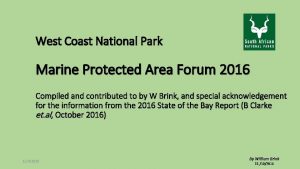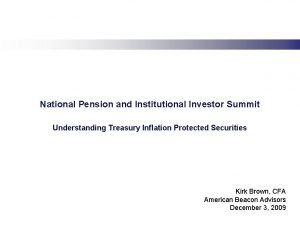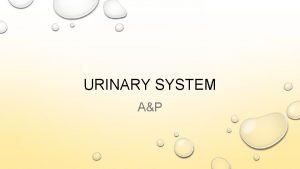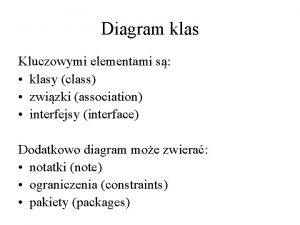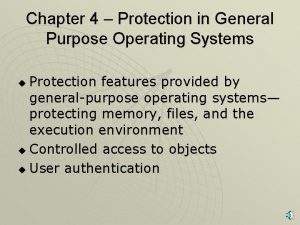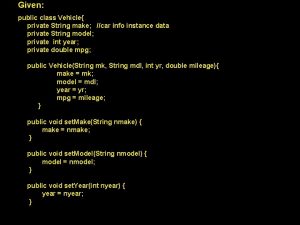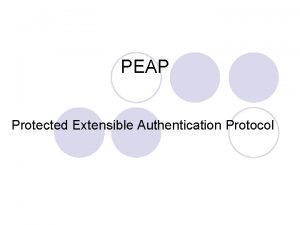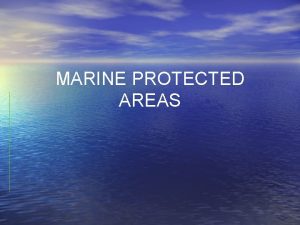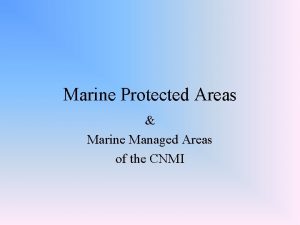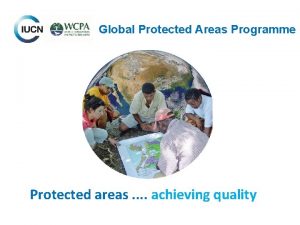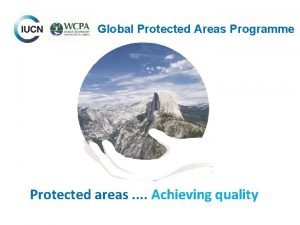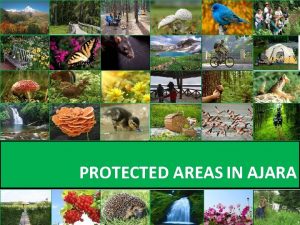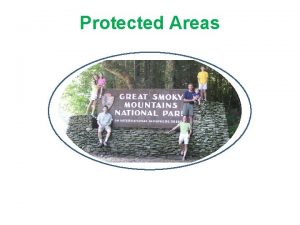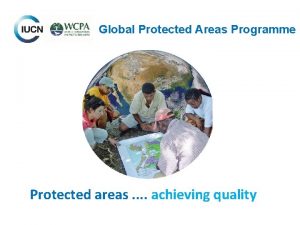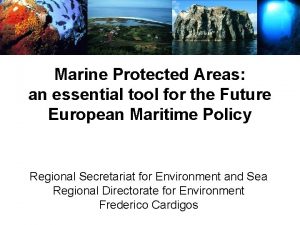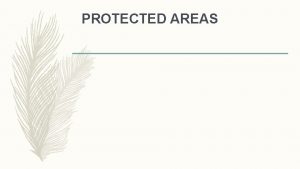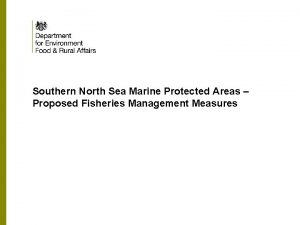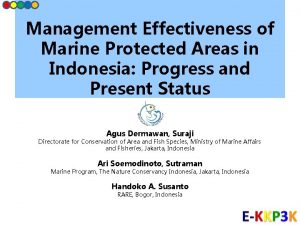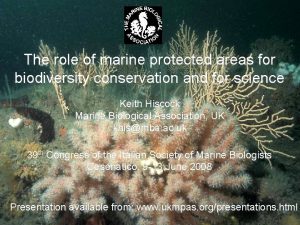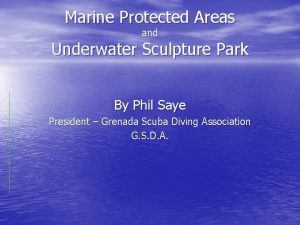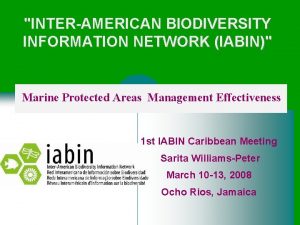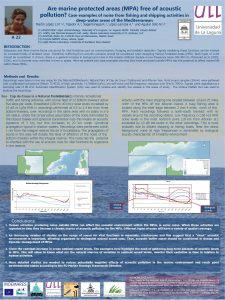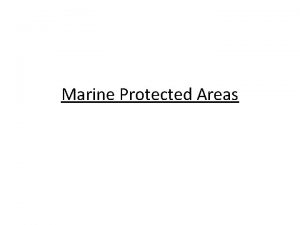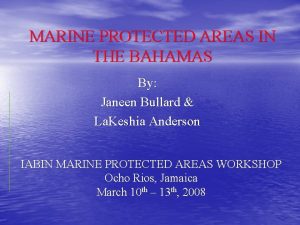Marine Protected Areas MPAs as a Tool for































- Slides: 31

Marine Protected Areas (MPAs) as a Tool for Environmental Sustainability: A Case Study of the Gully Off Nova Scotia, Canada* Professor David Vander. Zwaag Canada Research Chair in Ocean Law & Governance Marine & Environmental Law Institute Dalhousie University, Halifax, Nova Scotia Paul Macnab Oceans & Coastal Management Division Fisheries and Oceans Canada Dartmouth, Nova Scotia The Colloquium of the IUCN Academy of Environmental Law Wuhan, China (November 4, 2009) * This power point is drawn from a full case study of the Gully MPA to be included as one of 12 case studies accompanying the Guidelines to Protected Area Legislation, expected to be published by the IUCN Environmental Law Centre in 2010 as part of a project carried out by the Centre in cooperation with the Commission on Environmental Law and World Commission on Protected Areas, and in collaboration with the IUCN Environmental Law Academy and the University of Ottawa.

Introduction • Marine Protected Areas – Should Be Viewed as Part of the World’s Environmental Sustainability “Tool Kit” + MPAs May Help “Replenish” the Biodiversity of Adjacent Marine Areas + MPAs Offer a Management Mechanism for Ensuring Human Uses of the Ocean Operate within the Constraints of Maintaining Ecosystem Integrity and Health + MPAs May Help Address Climate Change – Acting as “Blue Carbon Sinks” Especially When Salt Marshes, Seagrasses and Mangroves Are Protected (Mitigation) – Serving as “Precautionary Buffers” to Marine Stresses Linked to Climate Change Such as Rising Ocean Temperatures (Adaptation)

• The MPA Concept Is Not Opposed To Securing Sustainable Livelihoods + The IUCN Definition of a “Protected Area” Recognizes the Importance of Human Dependencies A Protected Area Is: “A clearly defined geographical space, recognised, dedicated and managed, through legal or other effective means, to achieve the long-term conservation of nature with associated ecosystem services and cultural values. ” (Source: Dudley, N. (Editor) (2008) Guidelines for Applying Protected Area Management Categories. Gland, Switzerland: IUCN. X + 86 pp. )

+ IUCN’s Categories of Protected Areas Run from “No Take”, Strict Preservation Zones to Sustainable Use Areas – Category 1 a – Category 1 b – Category III – Category IV – Category VI Strict Nature Reserve Wilderness Area National Park Natural Monument Habitat/Species Management Protected Landscape/Seascape Protected Area with Sustainable Use of Natural Resources

• MPA Establishment Has Lagged Around the Globe + Only Just Over 5, 000 MPAs Covering Less Than 1% of Earth’s Surface + Compared to 115, 000 Terrestrial Protected Areas Covering Some 11. 9% of the Earth’s Surface

http: //www. wdpa-marine. org/#/countries/

http: //www. wdpa-marine. org/#/country/CN

• International Targets Have Been Set To Greatly Increase the Number of MPAs + Ensuring at Least 10% of Each of the World’s Marine and Coastal Ecological Regions Effectively Conserved (CBD Decision VIII/15) + Establishing Representative Networks of MPAs by 2012 (CBD Decision VII/5)

• This Presentation Provides a Canadian MPA Case Study of the Gully Submarine Canyon Off Nova Scotia

Northern bottlenose whale (Hyperoodon ampullatus) Conservation Status: Endangered population ~ 240 Protected under Species at Risk Act


• A 4 -Part Gully MPA “Cruise” Follows 1. 2. 3. 4. Specific Legislative and Regulatory Provisions Management Approaches Management Challenges Lessons To Be Learned

1. Specific Legislative and Regulatory Provisions • Main Vehicle for Establishing MPAs in Canada Is Under Canada’s Oceans Act + Provides MPA Definition 35 (1) A marine protected area is an area of the sea that forms part of the internal waters of Canada, the territorial sea of Canada or the exclusive economic zone of Canada and has been designated under this section for special protection … + Requires Minister of Fisheries and Oceans To Develop and Implement a Network of Marine Protected Areas

+ Sets Out Purposes for Designation (s. 35(1)) Conservation and Protection of: (a) commercial & non-commercial fishery resources including marine mammals & their habitats (b) endangered/threatened marine species & their habitats (c) unique habitats (d) areas of high biodiversity or biological productivity (e) any other marine resource or habitat as is necessary to fulfil the mandate of the Minister

+ Authorizes Federal Cabinet To Make Regulations Designating MPAs and Prescribing Measures Such as Zoning + Is Skeletal in Nature – No Process or Procedures Set Out for Selecting MPAs – No Timelines for Selecting and Developing MPAs – No Provision for Designation of Buffer Zones – No Explicit Call for MPA Management Plans + Offers Considerable Enforcement Powers • Gully Marine Protected Area Regulations Issued in 2004

+ Establish Boundary & Zones Area: 2360 km 2 Zone 1: Highly restricted deep-water core >600 m (few activities permitted) Zone 2: Protection for trough, canyon sides and outer area (some fisheries allowed) Zone 3: Shallow-water sandy banks <300 m (compatible uses subject to stringent review) PA Categories: Ia, IV, VI

+ A Three-Pronged Regulatory Approach Is Followed – General Prohibitions and Penalties Against Any Activities: * That Disturb, Damage, Destroy or Remove Any Living Marine Organism, Habitat or the Seabed to 15 m * Including Deposition, Discharge or Dumping of Any Substance * In the Vicinity of the MPA That Cause Any of the Above (D, D, D, R)

– Allowance of Some Activities Subject to an Activity Plan Submission and Approval by Minister of Fisheries and Oceans *Scientific Research May Be Allowed in All Three Management Zones *Other Approved Activities Limited to Zone 3 >Must Not Result in a Disturbance/Damage to Marine Organisms in Zones 1 or 2 >Disturbance/Damage in Zone 3 Must Be Within the Natural Variation of the Ecosystem

– Exceptions for Certain Activities Not Requiring an Activity Plan or Approval *Fishing for Halibut, Tuna, Shark and Swordfish in Zones 2 and 3 (Subject to Federal Fishing License Conditions) *Other Fishing Activities in Zones 2 and 3 Provided They Meet Various Conditions (Including Removal of Living Marine Organisms Must Be Within the Natural Variation of the Ecosystem) *Various Government of Canada Shipping and Aircraft Activities, Such as >Search and Rescue >Law Enforcement >National Security >Emergency Response

*MSR Carried Out or Sponsored by a Foreign Government That Has Received the Consent of the Minister of Foreign Affairs *Ships Exercising International Navigational Rights http: //www. cruisecritic. com/images/fred-olsen-balmoral-ship-at-sea. jpg

2. Management Approaches The Gully MPA Management Plan, Published in 2008, Provides Further Details and Guidance for Various User Groups on Management Approaches • Fisheries +Clarifies That Fishing in Zones 2 and 3 Will Be Prohibited Except for Longline Fishing for Halibut and Large Pelagics (Swordfish, Sharks, Tuna) Until an Assessment and Review Process Has Been Developed by DFO +Gives Notice of Enhanced Surveillance of the MPA

• Marine Scientific Research +Encourages Research and Monitoring with an Emphasis on MPA Understanding and Evaluation +Clarifies the Process for Domestic MSR Plan Approvals –Suggests Applicants Use an Application Form Developed by DFO –Provides for Review within 30 Days (by MPA Advisory Committee) +Expands on Foreign MSR Research Provisions –DFO will Review Foreign Research Applications and Provide Advice to the Minister of Foreign Affairs –Minister of DFO May Request That Supplying the Results of MSR Be Attached as a Consent Condition

• Marine Transportation +Emphasizes Ships Navigating in the MPA Will Be Subject to Various Pollution Control Laws –Canada Shipping Act, 2001 –Ballast Water Control and Management Regulations –Migratory Birds Convention Act, 1994 +Advises Vessel Operators of the Annual Notice to Mariners Giving Recommendary Guidance –Avoid the MPA if Possible –Slow Down –Post a Watch for Whales –No Discharges

• Oil and Gas Exploration/Exploitation +Highlights That While the Gully Regulations Do Not Prohibit Oil and Gas Activities within Zone 3, The Canada-Nova Scotia Offshore Petroleum Board Has Prohibited Exploration within the MPA Since 1998 as a Matter of Policy +Emphasizes That All Petroleum Activities Are Subject to the “in the Vicinity” Clause of the Regulation, That Is, They Must Not Cause Damage to the Gully Ecosystem +States That Those Undertaking Seismic Operations Will Have To Follow the Statement of Canadian Practice for the Mitigation of Seismic Noise in the Marine Environment +Encourages Voluntary Industry Codes of Practice To Protect the Gully

3. Ongoing Management Challenges Three Main Challenges Summarized • Putting Ecosystem Management into Practice + Still Limited Scientific Information and Understanding of the Marine Environment + A Gully MPA Monitoring Plan Has Yet to Be Finalized + Indicator Organisms of “Ecosystem Health” Still Being Considered (E. g. Krill for Contaminant Monitoring)

• Addressing Unresolved Legal Issues +What Exactly Do Key Legal Terms Mean? -“Disturbance” -“In the Vicinity” -“Natural Variation” +Should Future Prosecutions of Violations Be Brought under the Oceans Act or Related Legislation? (For Example, a Fishing Violation Could Be Prosecuted as a Violation of the Gully Regulations or the Fisheries Act)

• Ensuring Effective Governance +Limited Human and Financial Resources -General Understanding That Management Will Be Exercised under Existing Departmental Budgets -Only One Full-Time Gully MPA Manager Employed +Engaging All Relevant “Stakeholders” -Gully Advisory Committee Does Not Represent All Key Interests (E. g. First Nations and Mariners) +Building Adequate Public Awareness

4. Early Lessons To Be Learned • • • Time-Consuming Nature of MPA Establishment Usefulness of Multi-Purpose Zoning Need for a Multi-Agency Approach Value of Communication with User Groups Importance of Linking MPA Designation to Integrated Management Planning http: //www. dfo-mpo. gc. ca/oceans-habitat/oceans/im-gi/essim-giepne_e. asp

• Need for On-Going Law and Policy Review + Numerous Legal Issues Still Surround the Framework Legislation and Should be the Subject of Further Discussion, E. G. – Whether Certain Activities Like Hydrocarbon and Mineral Exploration/Exploitation Should Be Explicitly Prohibited in MPAs? – Whether Buffer Zone Establishment and Permitting Powers Should Be Put into Place? – How to Better Address Shipping Operations Near and Across the MPA (For Example, Through Possible Designation of the Gully MPA as a Particularly Sensitive Sea Area under IMO Auspices) where Restrictive Measures Would Apply.

– Whether MPA Management Planning Should Be Given a Legislative Basis? – Whether Integrated Management Planning Provisions of the Oceans Act Should Be Strengthened, For Example, by Specific Regulation-Making Power To Give Legal Teeth to Integrated Management Plans that Address Ocean Uses Adjacent to MPAs? – Whether Protecting Just One Submarine Canyon Important to the Endangered Northern Bottlenose Whale Is Sufficient http: //www. dfompo. gc. ca/csas/Cs as/status/2007/SAR -AS 2007_011_E. pdf

+ The Gully Management Plan Recognizes the Need for Periodic Review. A Complete Review of the Plan and Its Implementations Is Promised in 2010. Thank you!
 West coast national park marine protected area
West coast national park marine protected area Potter's wheel data cleaning tool
Potter's wheel data cleaning tool What are protected classes
What are protected classes Can i use protected pto to leave early
Can i use protected pto to leave early Treasury inflation protected securities cfa
Treasury inflation protected securities cfa Federally protected classes
Federally protected classes The kidneys are protected by the ribs and a cushion of fat
The kidneys are protected by the ribs and a cushion of fat Federally protected classes
Federally protected classes Dmca protected co to znaczy
Dmca protected co to znaczy Protected mode memory addressing
Protected mode memory addressing Is hair colour a protected characteristic
Is hair colour a protected characteristic Civil rights training quiz answers
Civil rights training quiz answers Protected void
Protected void Federally protected classes
Federally protected classes Protected weight bearing
Protected weight bearing Scope of protected cultivation
Scope of protected cultivation Protected objects and methods of protection
Protected objects and methods of protection Host protected area
Host protected area Ada protected object
Ada protected object Private string
Private string What is class attribute in java
What is class attribute in java How does extensible authentication protocol work
How does extensible authentication protocol work What landforms protected mesopotamia from invasion
What landforms protected mesopotamia from invasion High level wellness and grid model
High level wellness and grid model What protected rome from invasion
What protected rome from invasion Real protected and virtual modes of 80386
Real protected and virtual modes of 80386 Orubbliga rättigheter
Orubbliga rättigheter Big brother rösta
Big brother rösta Verktyg för automatisering av utbetalningar
Verktyg för automatisering av utbetalningar Vad är hsil
Vad är hsil Urban torhamn
Urban torhamn Vem räknas som jude
Vem räknas som jude
